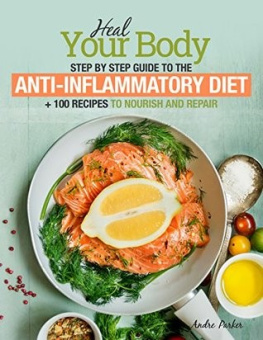Contents
Landmarks
Print Page List
PENGUIN
an imprint of Penguin Canada, a division of Penguin Random House Canada Limited
Canada USA UK Ireland Australia New Zealand India South Africa China
First published 2019
Copyright 2019 by Desiree Nielsen
All rights reserved. Without limiting the rights under copyright reserved above, no part of this publication may be reproduced, stored in or introduced into a retrieval system, or transmitted in any form or by any means (electronic, mechanical, photocopying, recording or otherwise), without the prior written permission of both the copyright owner and the above publisher of this book.
www.penguinrandomhouse.ca
LIBRARY AND ARCHIVES CANADA CATALOGUING IN PUBLICATION
Nielsen, Desiree, author
Eat more plants : over 100 anti-inflammatory, plant-based recipes for vibrant living / Desiree Nielsen.
Issued in print and electronic formats.
ISBN 9780735235717 (softcover).ISBN 9780735235724 (electronic)
1. InflammationDiet therapyRecipes. 2. Vegetarian cooking. 3. Cookbooks. I. Title.
RB131.N54 2019 6 41.563 C2018-905424-7
C2018-905425-5
Cover and interior design by Andrew Roberts
Photography by Janis Nicolay
Prop and food styling by Sophie McKenzie
v5.3.2
a
This book is dedicated to you for creating the intention to nourish your body well, and for taking the time to make cooking a part of your daily self-care. I hope that these recipes help you fall in love with plant food so you can feel amazing and reach your highest potential.
Contents
Introduction
I really like to eat. I also like to cook, so I can eat the food I enjoy the mosthealthy, energizing, and so delicious that there is no talk of compromise.
I have been a vegetarian for twenty years. I wish I could say I had noble intentions around making the change, but really, I did it to impress a boy I liked! True story. It is funny how life works; that short-lived teenage crush was the origin of a transformative shift for me. Becoming vegetarian led to a lifelong love of mindfulness, yoga, and of course, nutrition. Back then, I thought mac and cheese was the height of sophistication and health. Vegetarian eating meant no meat, but that did not necessarily equate to eating many whole plant foods.
Shortly after I became vegetarian, I tried a brief and somewhat disastrous stint with totally plant-based eating that left me hungry because I did not really know how to craft a nutritious plant-based meal. But times have changed. I am now a plant-based eater, but I did not get here overnight. It was a slow transition that felt positive and joyful at every step. Moving toward a more plant-based, anti-inflammatory eating plan is probably one of the most transformative actions you can take for your health. It will help you feel more energized and resilient in your everyday life. It will also help you prevent chronic illness and support you in healing.
It takes time to unlearn the hyper-processed eating pattern that is so common in our world. When you break rank with the status quo and dip your toe into plant-based living, it might feel foreign. It might even taste foreign (which is ironic, since by definition artificial sweeteners and colours are the foreign ingredients). However, when you explore it with a sense of playfree of absolutesyou will discover that this plant stuff is actually delicious. Of course, it is all in the approach. Go ahead and add a bit of extra salt or maple syrup to your meal if you need it to help you transition your taste buds. Have fun exploring plant-based versions of your favourite meals. Do not force yourself to eat foods you hate or attempt to cook tofu for the first time without a recipe, or you may think this healthy eating stuff isnt worth the price of admission.
By putting this book in your hands, you are on the right track. When you cook and eat these recipes, you may feel a bit peppier and want to feel that way again. It does not matter if you want nachos on a Friday night (and I have a queso recipe to help with that!). Just eat plants the rest of the time.
Plant-based eating is not about demonizing food or paying penance for indulgence. It is all about the yum and feeling good. Ignoring our bodies needs is not the right way to go. The same goes for demonizing large swaths of edibles. Describing all the things your diet is free of is kind of missing the point. Of course, if you are allergic to peanuts, there is a very critical point to their restriction. Someone with celiac disease is going to feel 100 percent better by ditching gluten. For the rest of us? Obviously, there is a middle way. In addition, what tends to define plant-based eating is an attitude of more, not less. If you want to eat well, forget the dogma and just focus on cooking the recipes in this book as often as you can. The more you do, the better you will feel.
As a dietitian, I want you to enjoy the act of cooking and eating, and to crave healthy foods. This is a major shift for many of us: it is unlikely that you will consume enough vegetables when you are forcing yourself to eat baby carrots at your desk and diving into big bowls of pasta the rest of the time. My intention with this book is to help you shake up your healthy food rut. To show you how delicious it is to adopt a more anti-inflammatory, plant-based diet so you can feel incredible. In addition, to give you recipes so doable you will actually make them.
How We Got Here: Unlearning Nutritionism
I totally understand if nutrition seems a bit confusing at times. Our collective desire to be healthier leads us to seek an enormous amount of food and nutrition information, and there are so many voices with differing opinions. So, how did we get here? To learn that, you have to take a deeper look at how nutrition evolves and how our food system uses nutrition to its own ends.
Food and nutrition are interconnected at the most basic level. We eat food, which contains nutrients, to nourish our bodies; nutrition is the study and application of how nutrients in food affect the body. However, the relationship between the two is not always harmonious.
The hyper-processed food choices we make today sometimes have very little in common with the food that grows out of the ground. Clever food manufacturers have figured out how to make hyper-processed foods taste as delicious and decadent as possible by including giant amounts of salt, sugar, and fat so you will eat more. Our knowledge of what excites taste buds, and what will entice us to eat more and buy more often, means that most coffee shop menus resemble dessert menus. Thanks to the wonders of modern food chemistry, some foods are so intoxicatingly easy to overeat that it becomes almost impossible to put them down, even if they seem born of the lab and not the kitchen. If you have looked at the ingredient list on a bag of neon-orange Cheetos, you know what I mean.




















